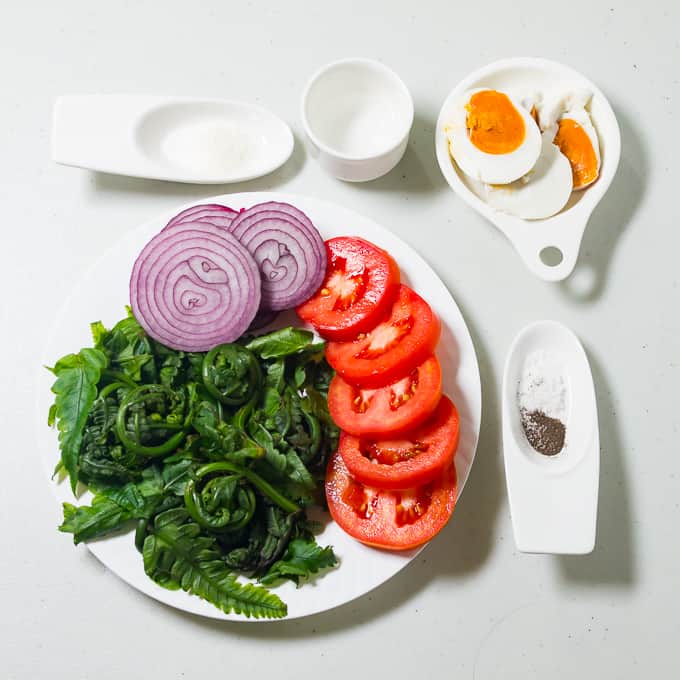Pako salad recipe (paco): Delicious & healthy fiddlehead fern
Pako salad (paco) is one of the fern vegetables that Filipinos love to eat.
This vegetable (fiddlehead fern, scientific name Athyrium esculentum) is usually eaten as a salad like Filipino fruit salad or as a side dish to a main viand.
Aside from its distinctive taste, pako is very well known to be healthy among Filipinos!
However, people aren’t really aware of what the nutritional value or benefits of this vegetable are. So here are some of the nutritional benefits of pako leaves!
As a vegetable, paco leaves are rich in fiber, which is an entirely healthy diet for people who are losing weight. Fiber takes time to digest, which allows people to feel full and lose the craving to eat.
It’s also good for people with heart problems and diabetes.
So why not try our refreshing salad recipe?
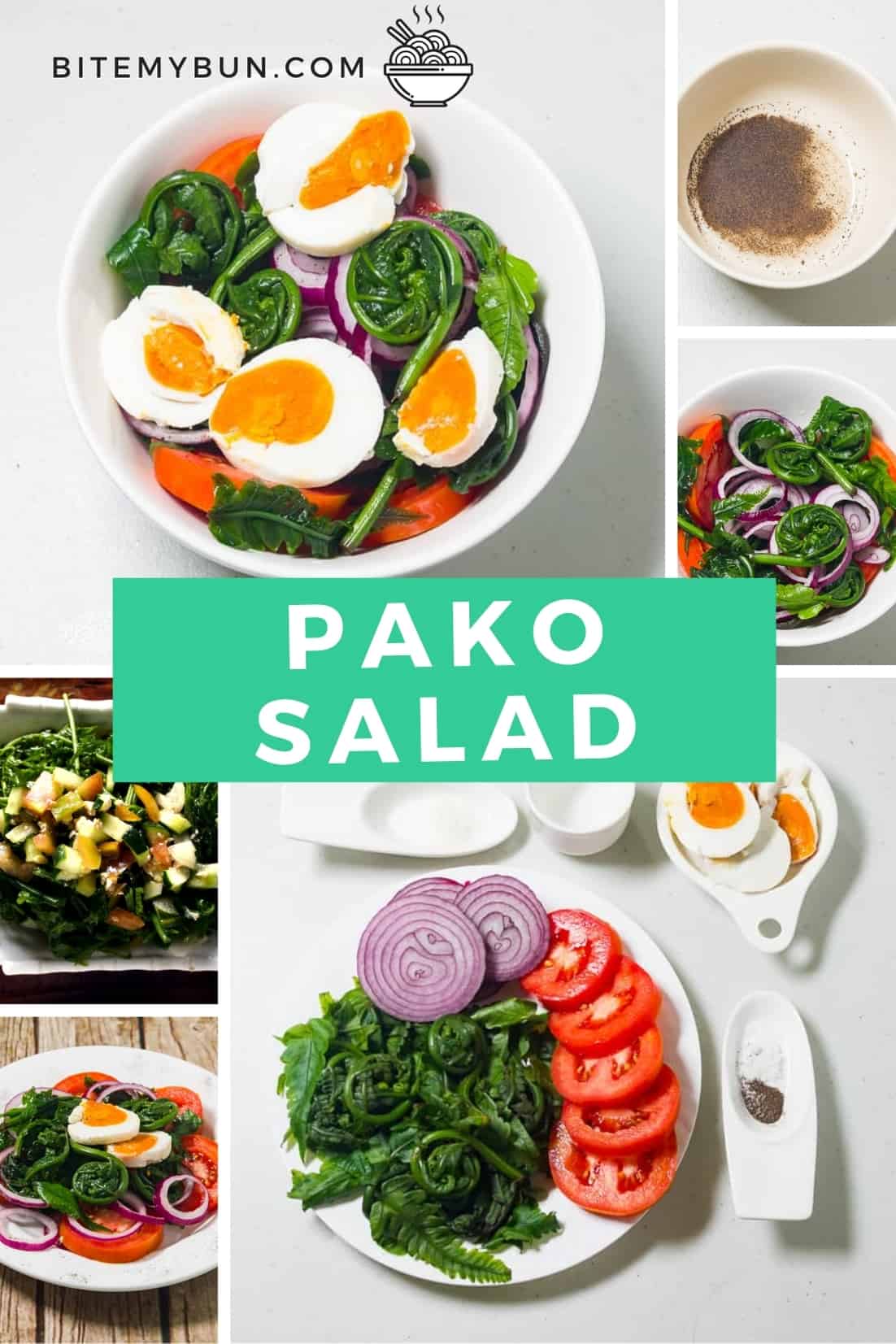

Check out our new cookbook
Bitemybun's family recipes with complete meal planner and recipe guide.
Try it out for free with Kindle Unlimited:
Read for freeIn this post we'll cover:
How to make pako salad at home
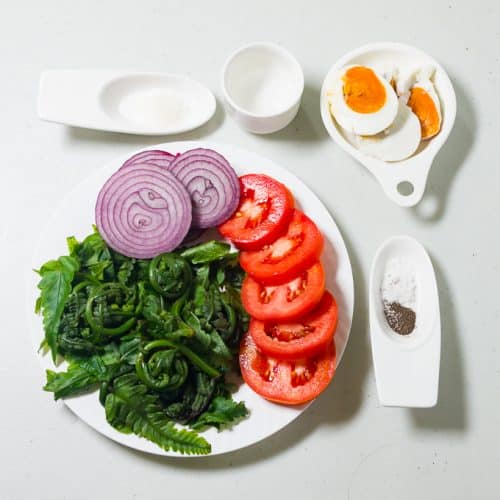
Pako salad recipe (paco)
Ingredients
- 4 cups pako leaves
- 2 tomatoes sliced
- 1 red onion sliced
- 1 salted egg sliced
Dressing
- 2 tbsp vinegar
- ¼ tsp salt
- ¼ tsp pepper
- ½ tsp sugar
Instructions
- Combine the ingredients for the dressing in a small bowl.
- Mix well and set aside.
- Wash and spin-dry pako leaves.
- Combine pako, tomato slices, and onion slices in a bowl and mix well.
- Drizzle with dressing and toss.
- Top with salted egg slices.
- Serve.
Check out this video by Simpleng Putahe PH to see how to make pako salad:
Where to find fresh pako
In the Philippines, pako is sold at most local markets and supermarkets. In Western countries though, it might be a little bit more difficult to find.
You can check the Asian section of your local supermarkets, or you could try looking for it at a local Asian market.
Pako leaves can be hard to find, but it’s worth looking out for.
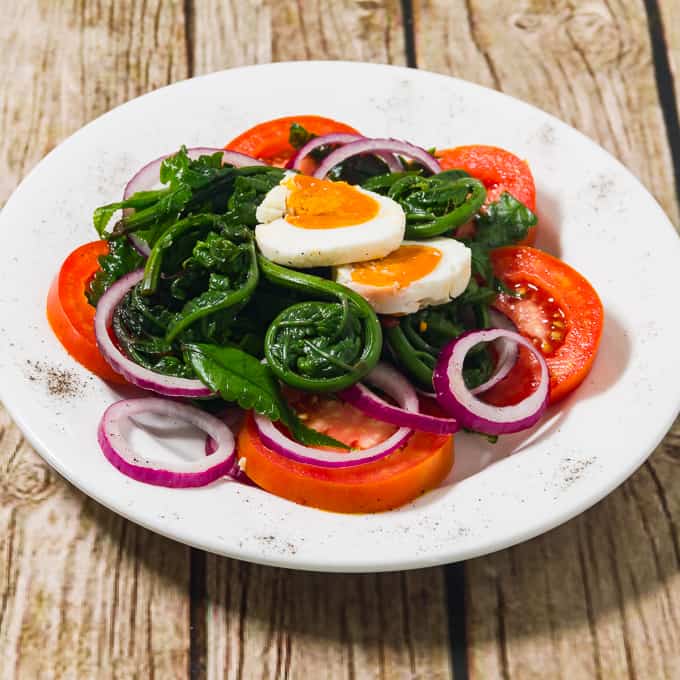
Cooking tips
When picking up pako, be sure the leaves aren’t wilted. They should be dark green, crisp, and fresh-looking.
If the pako is a bit tough, you can blanch it in boiling water for a minute or two to soften it.
Since the pako is eaten raw, it needs to be cleaned properly. All you need to do to prep the fern is to wash it under cold water to remove any dirt, and let the pako leaves soak in ice cold water to ensure all the impurities are removed.
Pat dry with a paper towel or clean kitchen towel.
Substitutions & variations
Pako is usually paired with vinegar, garlic, and onions. But feel free to experiment with other flavors.
Try adding some grated ginger, chili peppers, or a squeeze of lime juice to the dressing. If you want your dressing to be more flavorful, I recommend adding a splash of lemon juice too.
For a hint of sweetness, try adding a teaspoon of honey; it goes really well with the sourness of vinegar.
If you want a creamy dressing, add some mayonnaise or yogurt.
If you don’t have salted eggs on hand, you can use regular boiled eggs instead.
You can also change up the vegetables in this recipe (not the pako though) and use whatever you have on hand. Cucumber, cabbage, radish, and carrots would all be great in this salad!
If you’re looking for a garnish, some crumbled feta cheese will add a delicious flavor.
How to eat and serve
This is one of the easiest Filipino dishes to serve!
The salad can be eaten as is or served with rice. It can also be used as a side dish for grilled meats or fish.
This dish is great as an appetizer or side dish because it’s refreshing, delicious, and healthy!
If you’re looking for a light meal, then this is the perfect dish for you. If you’re serving this dish for a party or potluck, you can double the recipe to make sure there’s enough for everyone.
This salad is best served cold or at room temperature.
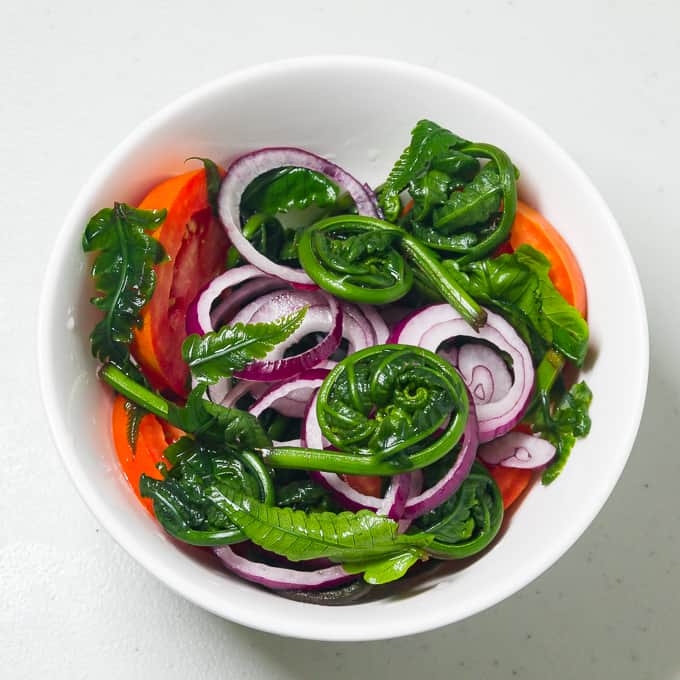
How to store
This salad is best enjoyed fresh while the leaves aren’t wilted. However, if you make a large batch of fern salad, you can store it in the fridge for up to 2 days.
To store, place the salad in a covered container or wrap it tightly with plastic wrap.
When you’re ready to eat it, remove the salad from the fridge and let it come to room temperature before serving.
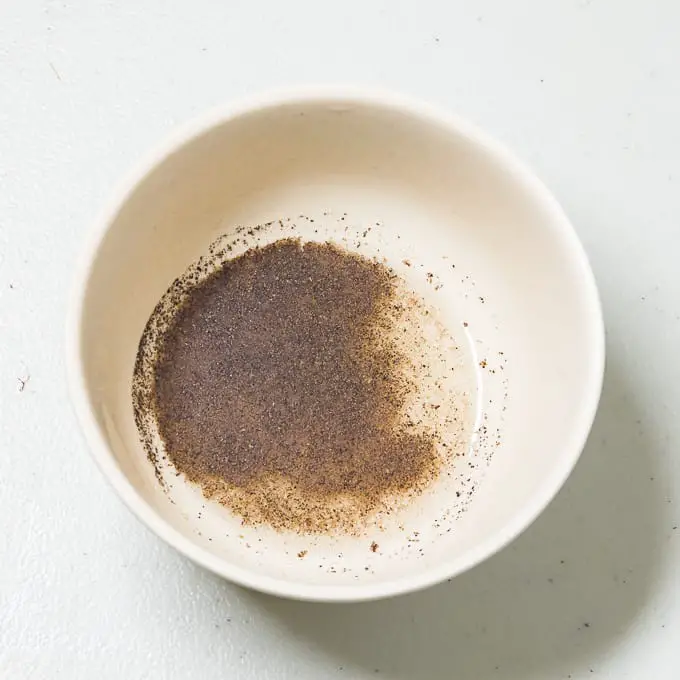
The tomatoes might leave a bit of liquid, so the salad can be soggy.
Health benefits
There’s no doubt that this is one of the healthiest salad recipes because of the high nutritional content of fiddlehead fern. It’s packed with vitamins and minerals!
Here are the main ones you can find when eating fern salad.
Calcium
One of the top minerals of pako is calcium. It’s helpful for our bones and teeth, and we normally get it from drinking milk.
Because of this, many people (especially old folks) claim that pako helps young people grow taller. It doesn’t spur growth though, but instead, helps support it by providing calcium to the growing bones.
Calcium is also useful for proper functioning of the heart, nerves, muscles, and other body systems.
For someone who’s suffering from premenstrual syndrome (PMS) and high blood pressure, a deficiency in calcium aggravates the problem. So edible fern (pako) can be of great use!
Researchers indicate that this indigenous vegetable is a good source of calcium. That’s why an ample serving of this food in your meal would help alleviate calcium-related problems.
Phosphorus
The second mineral in pako is phosphorus, which makes up 1% of our body’s total weight. This mineral helps our bodies burn carbohydrates and fats into energy.
It also helps create protein for growth and cell and tissue repair. So pako is said to help speed up healing of wounds.
It can also contribute a satisfactory amount to the suggested daily intake of phosphorus.
Iron
The third important mineral in pako is iron.
Iron is critical for distributing oxygen in the body through our blood and fueling our cells so they perform their functions. It’s also helpful for people who get easily woozy and weak due to iron deficiency.
The consumption of carefully selected fruits, vegetables, and herbs (like pako) can help you get back to normal life and solve iron deficiency without needing to buy costly supplementary iron capsules.
Thiamine (Vitamin B)
Pako salad is also rich in thiamine, which is more commonly known as vitamin B. Vitamin B is especially important for facilitating the smooth operation of our nervous system.
This water-soluble vitamin also helps break down carbohydrates into simple sugars.
Since pako is classified as a green leafy vegetable, this fern variety helps relieve known vitamin B deficiencies.
Vitamin A
This is a vitamin that helps maintain healthy eyes, and skin, as well as the respiratory system. So including pako as a part of your diet can improve your overall health.
Similar dishes
There are many Filipino salad recipes to try besides this one, like mango and tomato salad.
However, you can also try preparing pako in a few different ways.
For example, you can have steamed pako. This is a healthier way to enjoy fiddleheads since you won’t need to use any oil.
To do this, just wash the pako and place it in a steamer. Cover and let it steam for 3 to 5 minutes or until it’s cooked.
You can also sauté pako if you want a heartier dish. To do this, just heat some oil in a pan and sauté garlic until it’s brown. Add the pako and cook for 3 to 5 minutes.
Or you can cook the pako with sauteed garlic and onion, and then add some coconut milk. This is a delicious and creamy way to enjoy pako as a side dish.
FAQs
Can pako be eaten raw?
Yes, pako can be eaten raw. It’s often used in salads and has a crunchy texture.
However, pako must be washed or soaked in water to remove any potential toxins before eating it raw.
Is pako good for pregnant women?
Yes, pako is good for pregnant women. This vegetable is rich in calcium and iron, which are both essential for pregnant women.
Pako is also a good source of folic acid, which is important for the development of the baby’s neural tube.
Can pako be eaten by diabetics?
Yes, pako can be eaten by diabetics. This vegetable is low in carbohydrates and calories, making it a good choice for diabetics.
Pako is also a good source of fiber, which can help diabetics regulate their blood sugar levels.
What does pako salad taste like?
Pako salad has a slightly sour and salty taste. The texture is crunchy, and the flavor is refreshing.
How do you blanch pako?
Blanching pako is a simple process. Just wash the pako and then place it in boiling water for 3 to 5 minutes.
Remove the pako from the water and then place it in ice cold water to stop the cooking process. Drain the pako, then it’s ready to use in your recipes!
Have some refreshing pako salad
Pako salad is a refreshing and healthy dish. This Filipino recipe is perfect for a light meal or as a side dish.
You’ll be surprised at how tasty this unusual leafy green is compared to other salad veggies. The combination of salted egg, tomatoes, and onions and the vinegar-based sauce makes this salad so refreshing!
So if you’re looking for something new to try, give pako salad a shot!
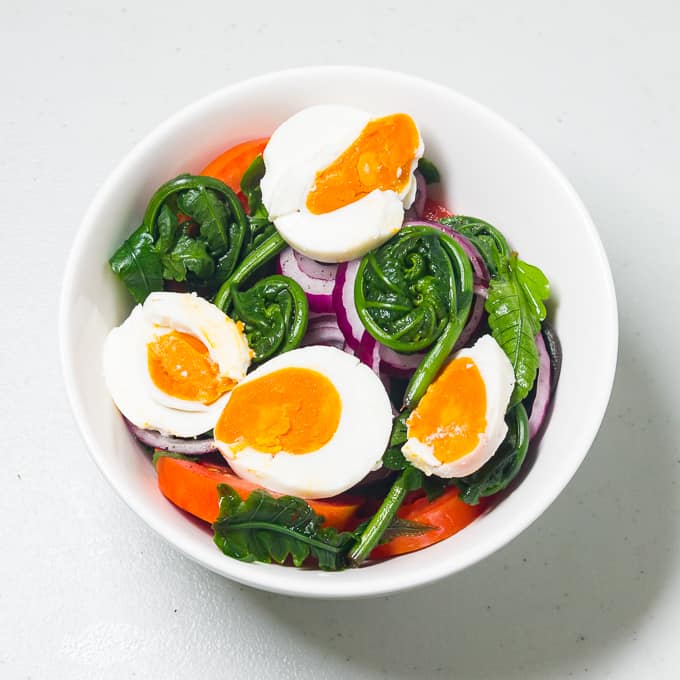
Salamat po.
To find out more about pako salad, read this article.
Check out our new cookbook
Bitemybun's family recipes with complete meal planner and recipe guide.
Try it out for free with Kindle Unlimited:
Read for freeJoost Nusselder, the founder of Bite My Bun is a content marketer, dad and loves trying out new food with Japanese food at the heart of his passion, and together with his team he's been creating in-depth blog articles since 2016 to help loyal readers with recipes and cooking tips.

